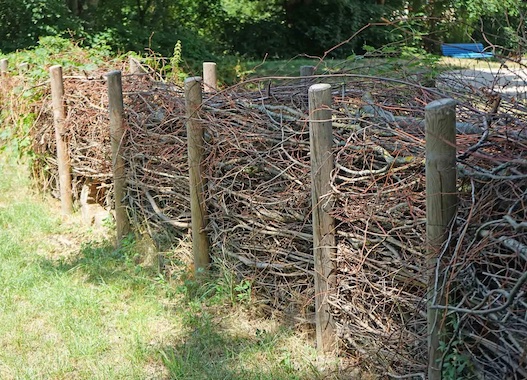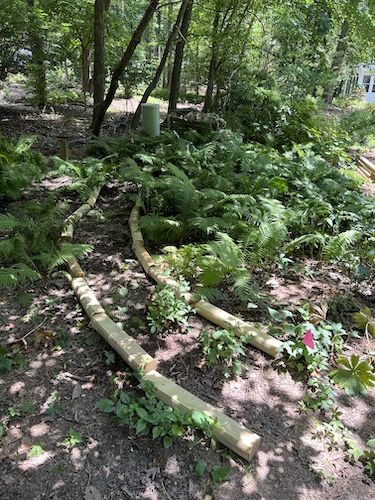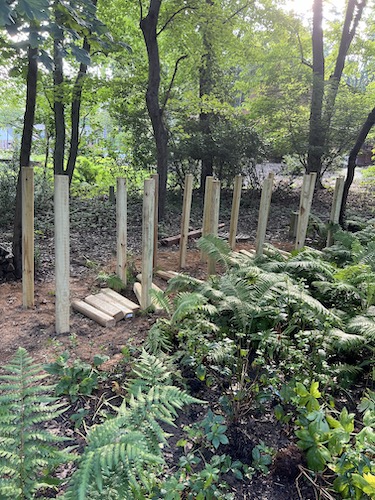Hedges Dead and Alive
by Jody Douglas, Fairfax Master Gardener Intern

Example of full dead hedge
“Enclosures made from plants were critical for safety and fortification for early civilizations while keeping some things in (animals) and others out (enemies and thieves). Property delineation was first defined by hedgerows that incorporated trees and evolved into the art and science of hedgelaying, still practiced in England and Europe.” A Short History of Hedges © 2021 by Mary Hockenberry Meyer
Europeans have for centuries used hedges constructed of various materials (rock, logs, brush, live dense trees or shrubs and brambles) to delineate property, contain livestock, protect their homes, etc. Over time the need for protective land management lessened, and the hedges evolved into lovely hedges used more for decoration.
We who live in Reston, with its many large trees, know the problem: we find ourselves with stacks of dead branches and twigs lying about after a storm, creating something of an eyesore. In my case, I’ve been planting native plants for a few years and have discovered that some grow very large, leaving piles of green waste standing in the spring when the overwintering insects have departed, and the new sprouts are coming out of the ground.
 My solution to all this debris became a “dead hedge”– a way to incorporate all the yard waste into one linear structure that is orderly, easily maintained, less of an eyesore and which becomes over time an “eco-pile.” As the materials placed in the hedge decompose, they put nutrients back into the soil so that nothing goes to waste.
My solution to all this debris became a “dead hedge”– a way to incorporate all the yard waste into one linear structure that is orderly, easily maintained, less of an eyesore and which becomes over time an “eco-pile.” As the materials placed in the hedge decompose, they put nutrients back into the soil so that nothing goes to waste.
There are a huge variety of structures under the dead-hedge rubric. Felder Rushing, an author and popular podcaster (The Gestalt Gardener on NPR) describes the dead hedge as “somewhere between a traditional split rail fence and a more tightly woven wattle.”
Just an aside, in my reading about the difference in debris structures, I’ve learned that the British call it a “brash” — piles of branches, twigs, leaves, weeds and other garden trimmings, while Americans call it “brush” for no good reason. When materials such as large compostable logs  (buried in the ground or laid on the surface), limbs, leaves and other debris are mounded and left to decompose into rich soil to be planted as a garden, the process is called Hügulkultur, or “mound gardening.”
(buried in the ground or laid on the surface), limbs, leaves and other debris are mounded and left to decompose into rich soil to be planted as a garden, the process is called Hügulkultur, or “mound gardening.”
Dead-hedge structures are teeming with life. They provide shelter for small mammals and birds, a place to hide from predators and the elements and are home to many types of insects. Even during construction of our hedge, I saw spiders, pill bugs and birds making use of the hedge for shelter. A pair of wrens has already taken up residence, and I’m hoping the native bees will find it useful as well. Even a tiny Spring Peeper (tree frog) made an appearance one evening — the first I’d seen in my yard in years.
In constructing our dead-hedge, I opted to use pressure-treated fence posts  for the uprights and placed them in two parallel rows, offset every few feet, and about 2 feet (60 cm) apart, at the rear of the property. I also decided to give the structure a lazy S curve, rather than place it in a straight line. My husband suggested I paint the posts to blend into the woods more, so they’re dark brown in color. I’ve begun filling it with the several piles of limbs that had been stacked around the yard, along with much of the spent “green waste.” I’ll continue to add to it over time, inserting brush and small organic debris between the larger sticks.
for the uprights and placed them in two parallel rows, offset every few feet, and about 2 feet (60 cm) apart, at the rear of the property. I also decided to give the structure a lazy S curve, rather than place it in a straight line. My husband suggested I paint the posts to blend into the woods more, so they’re dark brown in color. I’ve begun filling it with the several piles of limbs that had been stacked around the yard, along with much of the spent “green waste.” I’ll continue to add to it over time, inserting brush and small organic debris between the larger sticks.
In summary, dead hedges are free, easy to build and “feed.” Any organic matter can be put on top or inserted in the sides, providing a breeding place, feeding place and shelter for any number of birds, mammals and insects, as well as enrich the soil. What’s not to love?
-
References
- Building a Dead Hedge — Enhance Your Garden with a Unique Winter Project, Caston Noorullah, University of Georgia Cooperative Extension
- Hedges, Mary Hockenberry Meyer and Nick Kreevich, University of Minnesota
- The Dead Hedge is Alive, Felder Rushing, The Gestalt Gardener
- Permaculture – The Dry Hedge, www.rainwaterrunoff.com